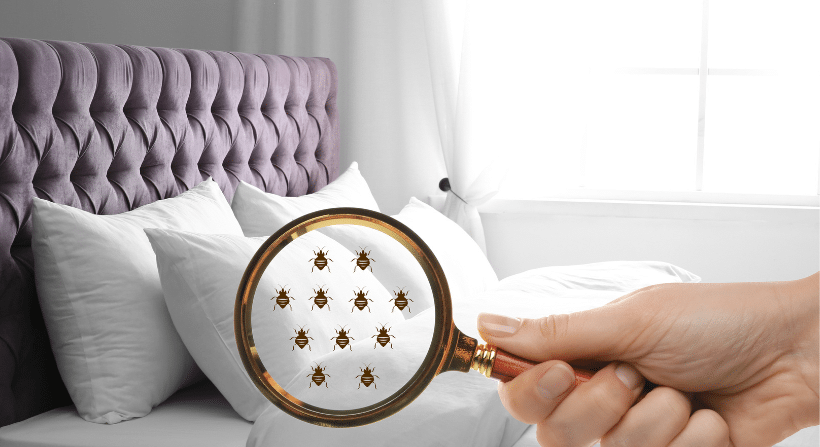Have you ever wondered if bed bugs only come out at night? These tiny pests can be a big problem, and many people think they only show up when it’s dark. In this blog post, we’ll look at whether bed bugs are really just nighttime creatures or if they can be active during the day too.

By learning more about when these bugs come out, we can figure out how to find them and get rid of them more easily. Let’s dive in!
Do Bed Bugs Only Come Out at Night?
Bed bugs, those tiny, elusive insects known for their itchy bites, are often associated with nocturnal activity. Many people believe that these pests only come out at night, leading to the assumption that bed bug bites happen exclusively while we sleep. But is this really the case? Understanding the behavior of bed bugs can help us better manage and prevent infestations. Here’s a detailed look into whether bed bugs only come out at night and what influences their activity.
Understanding Bed Bug Behavior
These bugs are small, wingless insects that feed on the blood of humans and animals. They are primarily nocturnal, meaning they are most active during the night. This nocturnal behavior is driven by their need to feed on hosts who are typically inactive and easier to approach when asleep.
Nighttime Activity
- Feeding Habits: Bed bug prefer to feed when their hosts are stationary and less likely to notice or disturb them. Nighttime offers the perfect conditions as humans are generally asleep and motionless, making it easier for bed bugs to feed undetected.
- Light Sensitivity: Bed bug have an aversion to light and prefer dark environments. This preference reinforces their nighttime activity as they avoid daylight and artificial light, which can expose them to potential threats and reduce their chances of a successful feed.
Daytime Activity
While bed bugs are predominantly nocturnal, they are not exclusively so. Several factors can cause them to come out during the day:
- Hunger: If bugs are extremely hungry and haven’t fed in a while, they might break their usual pattern and come out during the day in search of a meal.
- Disturbance: Disturbances such as cleaning, rearranging furniture, or other activities that disrupt their hiding places can cause bed bug to become active during daylight hours.
- Heavy Infestation: In cases of severe infestations where bed bugs are numerous, the competition for food might drive some to seek hosts during the day to avoid the crowded nighttime feeding frenzy.
Where Do Bed Bugs Hide?
Regardless of the time of day, bugs are adept at hiding in small, secluded spots near their food source. Common hiding places include:
- Mattresses and Box Springs: Seams, folds, and crevices are favorite hiding spots.
- Furniture: Bed bugs can hide in cracks, seams, and cushions of sofas, chairs, and other furniture.
- Wall Cracks and Floorboards: Any small crevice in walls, floors, or baseboards can serve as a hiding place.
- Personal Belongings: Purses, luggage, and clothing can harbor bed bugs, especially if these items are placed near infested areas.
Detecting Bed Bug Activity
Because bugs are skilled at hiding, detecting their presence requires vigilance. Signs of bed bugs include:
- Bite Marks: Small, red, itchy welts often appear in clusters or lines on the skin.
- Visual Sightings: Spotting live bed bugs, their shed skins, or tiny white eggs is a clear sign of infestation.
- Fecal Spots: Tiny dark spots on bedding, furniture, or walls are bed bug excrement.
- Musty Odor: A strong, musty odor can indicate a heavy bed bug infestation.
Preventing and Managing Bed Bug Infestations
To minimize the risk of encountering bed bugs and manage any potential infestations, consider these strategies:
- Regular Inspections: Frequently check mattresses, bed frames, and furniture for signs of bed bugs, especially in seams and crevices.
- Cleanliness: Maintain a clean environment by regularly vacuuming carpets, floors, and furniture. Dispose of the vacuum bag immediately to prevent bed bugs from escaping.
- Protective Covers: Use bed bug-proof encasements on mattresses and box springs to reduce hiding places.
- Careful Handling of Second-Hand Items: Inspect and clean any second-hand furniture, clothing, or luggage before bringing them into your home.
- Professional Help: If you suspect a bed bug infestation, contact a professional pest control service for a thorough inspection and treatment plan.
Also read: Can Bed Bugs Get Into Your Vehicle?
Conclusion
While bed bugs mainly come out at night to feed, they can also be active during the day if they are hungry, disturbed, or if the infestation is severe. Understanding their behavior and recognizing the signs of an infestation are crucial for effectively preventing and managing these pests. If you suspect a bed bug problem, don’t wait take action immediately.
At Tulsa Bed Bug Exterminator, we specialize in thorough and effective bed bug elimination. Our expert team uses advanced techniques to ensure your home is safe, comfortable, and bed bug-free. Contact Tulsa Bed Bug Exterminator today for reliable and professional pest control services, and say goodbye to bed bugs for good.

Recent Comments